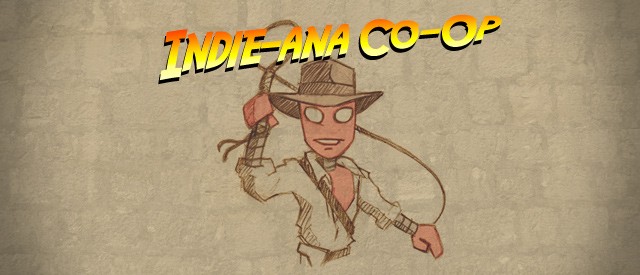Co-Optimus: Tell us a little bit about yourselves. How did you both get into game development? How did you meet?
Jesse: We met in CP Biology class sophomore year of high school. Beau was the weird quiet kid in the back and I was the one in front that wouldn’t shut up and always got yelled at. At some point we were partnered together to dissect fetal pigs. Over the stench of ammonia-soaked fetus organ we eventually discussed how we both loved to play video games and even both designed them in our sketchbooks. When he invited me over and showed me a silly little program called Klik n Play one day, the fate of our universes was written.
Co-Optimus: What was the genesis of Wyv and Keep?
Beau: Wyv and Keep started out a longggg...time ago in a different programming language and as a very different game from what it has become. The premise was always a platforming puzzle game where two players would work together to get boxes to switches. But the original WnK world was filled with orange and blue alien characters marching boxes across plains of purple grass. It was also a grid-based game. Pressing an arrow key would advance the players 1 grid segment, which made it very exact, but also a little harder to tell what was going on between all the teleporting about.
Jesse: The original also had Atari sounds and the Donkey Kong starting jingle. It was sad to see those go...
Co-Optimus: Looking through your site's blog, it looks like developmet of Wyv and Keep began back in 2009 . Has a lot changed since that time? Was there always a clear goal of what you wanted Wyv and Keep to be? Have you added more to it than you originally intended?
Beau: This ties in strongly with the above. The game actually started more along the lines of 2000. The original version was given a castle make-over, but ran into programming difficulties and ended up being shelved. We opened it back up with the new version in 2009, once again in the castle, but highly modernized. We did away with the grid-based restraints, and gave it a full platform movement. We also eventually did away with the castle and moved the setting to the jungles of Amazonia. Needless to say, the project went from being a “few months” to the full-scale multi-year endeavor we’re still chugging away on.
Jesse: There was a good seven or eight year break in there! We didn’t work on it for 12 full years... though sometimes it feels like that...

Wyv and Keep features plenty of puzzles and perils for the duo to face as a team as they explore the depths of the temple
Co-Optimus: The game’s overall aesthetic is one that, for me, invokes many fond memories of sitting in front of my TV with an SNES controller in hand. Why pixel art, though? Is it purely for nostalgia reasons, or are there technical/programming reasons behind it, too?
Jesse: Thanks so much! It’s an honor that you’d compare us to games on the SNES. If you hadn’t guessed, we certainly have nostalgia for the 16-bit days. These were days of smaller studios, creative design, innovative solution, and little corporate interference. Game design was purer then, much like film was in the 70s and early 80s. Modern games can be beautiful in their own ways, but somehow the capability to basically do anything has lost much of the romanticism. Like a freshly painted canvas vs. a high-resolution photoshop composite. Limitations always spur creativity, and for me trying to fit Wyv’s exaggerated expressions and Keeps’ voluminous hair into 18px2 were projects in themselves. I suppose for us low resolution pixel art isn’t so much a choice as it is just natural. We kind of just start on 16 or 32 pixel grids without thinking. We’re certainly interested in high-definition art and will be exploring it in the future, but it’s safe to say many (maybe a majority?) of our projects will continue to be good and pixely.
